Table of Contents
As an IT or Software Asset Management professional, your role in software license management is indispensable. It’s not just about ensuring compliance and cost optimization, but also about making strategic decisions that can significantly impact your organization’s software investments. However, the methods for tracking licenses can vary greatly between on-premises software and SaaS applications.
With SaaS, license and usage data are readily available in the app’s admin panel. This immediate access simplifies tracking and ensures real-time insights into your license status. On the other hand, for on-premises software, you often rely on periodic audits with your vendor to understand your license positioning, which can be time-consuming and less transparent.
Jason Owens, Sr. Director, Global ITAM at Salesforce, highlights this difference. “There is a dichotomy when it comes to looking at compliance-focused traditional on-prem for license management and ELP delivery. And then there’s SaaS. We don’t really need ELPs because we can see our current license position in the portal at the drop of a hat.”
Tracking software licenses is now easily accessible. The issue is the absence of a centralized system to manage licenses for your numerous SaaS applications. On average, that’s 275 applications, or 660 in the enterprise. This can cause inefficiencies, higher expenses, and compliance risks.
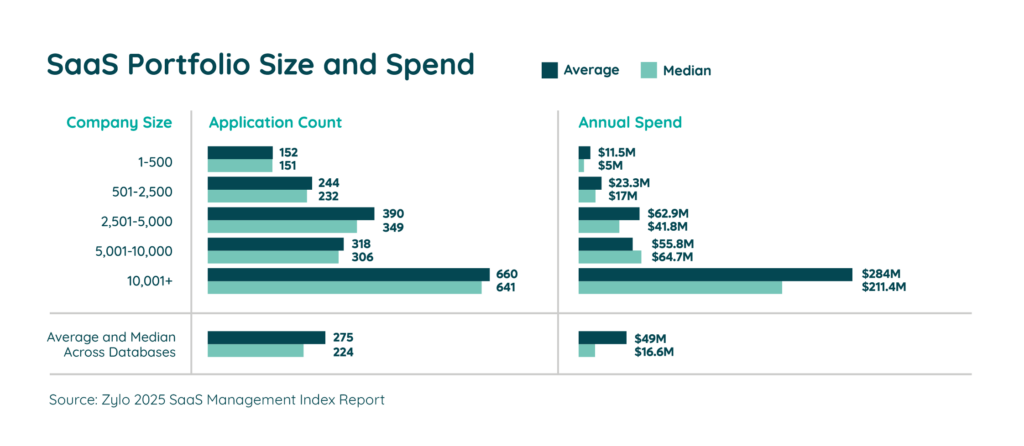
Why You Need to Track Software Licenses
Tracking software licenses promotes efficiency by helping organizations identify and eliminate unused or underutilized licenses. In short, it ensures you pay only for what is used. With hundreds of applications, unused licenses here and there add up.
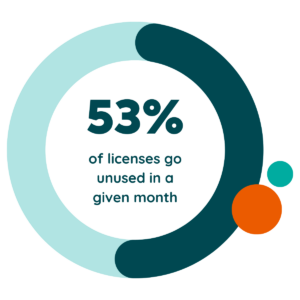 According to our data, an average of 53% of SaaS licenses remain unused monthly. That results in a staggering $21M in annual waste – or $127.3M for large enterprises. Effective license management is essential to prevent significant financial waste by aligning actual needs with expenditures.
According to our data, an average of 53% of SaaS licenses remain unused monthly. That results in a staggering $21M in annual waste – or $127.3M for large enterprises. Effective license management is essential to prevent significant financial waste by aligning actual needs with expenditures.
For Trenton Cycholl, VP, Digital Business at ModMed, software license management is vital. “First, it simplifies the technology we use and how we use it, making our operations leaner and more agile. Second, it’s a direct path to controlling and reducing costs.”
By managing software licenses efficiently, organizations can not only streamline their tech stack but also make substantial cost savings, redirecting funds to more strategic initiatives.
Tracking your software licenses enables you to:
- Understand your effective license positioning (ELP): Track your software licenses to see your actual usage versus what you purchased. This will allow you to identify over-licensing, under-licensing, or non-compliance and make informed decisions.
- Avoid unnecessary license purchases: By monitoring license utilization, you can avoid buying new licenses you don’t need so you don’t incur additional, unplanned costs.
- Adjust license quantities at renewal based on usage: Usage data from license tracking informs strategic decisions during renewals to adjust license numbers and negotiate better pricing.
- Consolidate redundant applications: License tracking helps you identify and consolidate redundant software, streamlining your IT support and reducing costs.
These practices enable organizations to maximize their software investments and maintain agility to meet evolving business requirements.
Questions to Answer About Your Licenses
Tracking your SaaS licenses allows you to answer critical questions around users, utilization, and adoption.
What Software Has Especially Complex Licensing?
SaaS vendors lack a uniform licensing model. That complicates license management for IT and Software Asset Management teams due to the variety of models and their unique rules.
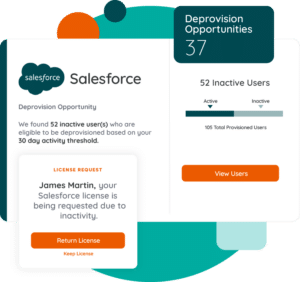 Software with complex license agreements, like enterprise licenses and those for frequently used software, often pose the greatest compliance challenges due to their detailed terms and metrics.
Software with complex license agreements, like enterprise licenses and those for frequently used software, often pose the greatest compliance challenges due to their detailed terms and metrics.
For instance, Salesforce, with its many license tiers and products, exemplifies this complexity. Its widespread use requires meticulous license management. This highlights the need for a comprehensive system to track licenses, maintain compliance, and manage software spending effectively.
How Many Licenses Are Being Used or Wasted?
Ideally, you want a 90% utilization rate for your software licenses. However, achieving this rate can vary depending on each tool’s specific use case. Different platforms have different licensing models and usage requirements that can impact utilization rates.
“It really comes down to the discrete licensing model for each platform. Look at incentive compensation planning, where everybody in the user pool has to have access to it,” explained Owens. “The usage and utilization may not be as important, because if a salesperson needs to see what their incentive compensation looks like, they need to have access no matter what.”
To meet your target utilization rate, consider training for better user engagement, regular license reclamation to prevent superfluous purchases, or adjusting licenses to match usage, ensuring a right-sized contract at renewal.
Effective license management helps maximize software investment value and efficiency.
What License Types Are Being Used?
Apps often have varied user licenses, from full access to read-only, depending on the features an employee needs. These licenses serve different roles and carry distinct costs, with full access typically more expensive than limited access.
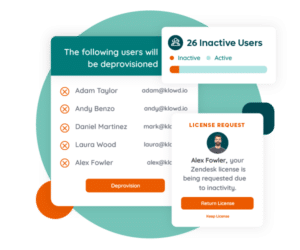
Understanding each user’s interaction with the software requires detailed usage data. This includes tracking feature usage, essential role functionalities, and if some users could use a less costly license.
IT and Software Asset Management teams can use this data to allocate licenses effectively, balancing access with cost. Proper license management optimizes costs and ensures employees have the necessary tools to do their jobs.
How Many Users Have Licenses to Multiple Redundant Tools?
Organizations can analyze usage data to identify users with access to redundant SaaS applications and consider consolidating them. Redundant tools not only incur unnecessary costs but also complicate the tech stack.
Consolidation reduces confusion, underutilization, and wastage, ensuring users have the best tools and simplifying the software environment.
A thorough analysis of usage patterns lets you identify the most effective tools and eliminate redundant ones, improving operational efficiency and maximizing software investment returns.
The IT Leader’s Guide to Software License Management
Learn MoreHow to Effectively Track Your Software Licenses
To effectively track your software licenses and maintain control over your SaaS environment, you should:
 Conduct ongoing discovery: Maintain an up-to-date inventory of SaaS applications used in your organization. Discovering all the software in your environment must be ongoing, as new applications enter the environment constantly. According to our data, an average of 7 apps enter an organization each month, or 12 in the enterprise.
Conduct ongoing discovery: Maintain an up-to-date inventory of SaaS applications used in your organization. Discovering all the software in your environment must be ongoing, as new applications enter the environment constantly. According to our data, an average of 7 apps enter an organization each month, or 12 in the enterprise.
- Centralize usage data: Collect usage data for all applications in one platform, like a license dashboard, to facilitate management. Direct integrations, APIs, and other connections can put the data you need in one place.
- Analyze usage insights: Review the data to understand application adoption, user behavior, and redundant tool access. A tool like Zylo analyzes your usage data to recommend actionable optimization opportunities.
- Optimize licenses: Based on data insights, adjust license tiers, reclaim unused licenses, and modify quantities at renewal to reduce costs. Often, this looks like cost avoidance or cost savings. Avoid incurring new costs by reclaiming and reassigning unused or underused licenses. If a new license quantity makes sense at renewal, turn that optimization into cost savings.
- Implement alerts: Set alerts for when new subscriptions or applications are added to promptly integrate them into your management system. This brings shadow IT to light quickly so you can centrally manage it.
- Establish governance: Create policies to prevent unauthorized software purchases and ensure IT/SAM manages all licenses. There’s not a one-size-fits-all approach to SaaS governance. Partner with key stakeholders in Security, Finance and Procurement to determine what policies make sense.
Use a Tool to Track Software Licenses
Today, organizations have three primary tools for managing software licenses: spreadsheets, Software Asset Management (SAM) tool, and SaaS Management platform (SMP). When it comes to SaaS an SMP is the best option. Let’s break down each tool to understand why.
Spreadsheets
Spreadsheets are accessible and low-cost but require manual data entry, which is time-consuming and error-prone. They lack scalability, real-time data, and integration capabilities, making them inefficient for managing large or complex licensing needs.
Software Asset Management Tool
SAM tools automate tracking and ensure compliance, offering robust reporting features. However, they can be complex to implement and expensive, and they often focus on on-premises software rather than SaaS applications. Typically, you’re only looking at IT or SAM-owned software, not your full inventory.
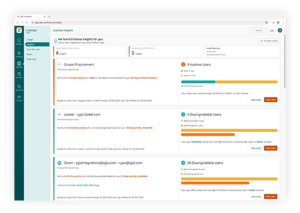
SaaS Management Platform
A SaaS Management platform provides centralized, real-time insights into license usage, automates tracking, and integrates with other systems. It helps you optimize licenses, set up alerts for new subscriptions, and establish governance to prevent shadow IT. While there is an initial setup effort, the comprehensive benefits make SaaS Management platforms the superior choice for modern organizations.
“This isn’t my first journey with license management across multiple technology and solution platforms. I tried and failed before using spreadsheets and multiple data sources to try to manage this challenge,” shared Cycholl. “Centralizing key data is an absolute step zero. And Zylo was a quick and simple way to accomplish this.”
Ready to Optimize Your SaaS Licenses?
It’s time to take control of your software licenses, reduce waste and increase adoption. Discover how a comprehensive platform can transform your license management strategy. Learn more about how Zylo can help with your SaaS License Management.


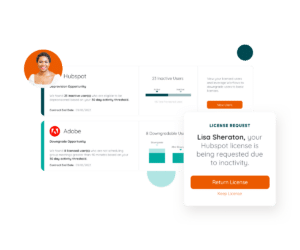 Conduct ongoing discovery
Conduct ongoing discovery